Impact of Annealing Temperature on the Physical Properties of the Lanthanum Deficiency Manganites
Abstract
:1. Introduction
2. Experimental Details
3. Results and Discussion
4. Conclusions
Acknowledgments
Author Contributions
Conflicts of Interest
References
- Tishin, A.M.; Spichkin, Y.I. The Magnetocaloric Effect and Its Applications; IOP Publishing Ltd.: Bristol, UK, 2003. [Google Scholar]
- Mira, J.; Rivas, J.; Rivadulla, F.; Vázquez-Vázquez, C.; López-Quintela, M.A. Change from first- to second-order magnetic phase transition in La2/3(Ca,Sr)1/3MnO3 perovskites. Phys. Rev. B 1999, 60, 2998. [Google Scholar] [CrossRef]
- Chahara, K.; Ohno, T.; Kasai, M.; Kozono, Y. Magnetoresistance in magnetic manganese oxide with intrinsic antiferromagnetic spin structure. Appl. Phys. Lett. 1993, 63, 1990. [Google Scholar] [CrossRef]
- Von Helmolt, R.; Wecker, J.; Holzapfel, B.; Schultz, L.; Samwer, K. Giant negative magnetoresistance in perovskitelike La2/3Ba1/3MnOx ferromagnetic films. Phys. Rev. Lett. 1993, 71, 2331. [Google Scholar] [CrossRef] [PubMed]
- McCormack, M.; Jin, S.; Tiefel, T.H.; Fleming, R.M.; Phillips, J.M.; Ramesh, R. Very large magnetoresistance in perovskite-like La-Ca-Mn-O thin films. Appl. Phys. Lett. 1994, 64, 3045. [Google Scholar] [CrossRef]
- Jin, S.; Tiefel, T.H.; McCormack, M.; Fastnacht, R.A.; Ramesh, R.; Chen, L.H. Thousandfold change in resistivity in magnetoresistive La-Ca-Mn-O films. Science 1994, 264, 413. [Google Scholar] [CrossRef] [PubMed]
- Khlifi, M.; Dhahri, E.; Hlil, E.K. Magnetic, magnetocaloric, magnetotransport and magnetoresistance properties of calcium deficient manganites La0.8Ca0.2−x⌷xMnO3 post-annealed at 800 °C. J. Alloys. Compd. 2014, 587, 771–777. [Google Scholar] [CrossRef]
- Skini, R.; Khlifi, M.; Wali, M.; Dhahri, E.; Hlil, E.K.; Lachkar, P. Electrical transport and giant magnetoresistance in La0.8−x⌷xCa0.2MnO3 (x=0, 0.1 and 0.2) oxides. J. Magn. Magn. Mater. 2014, 363, 217–223. [Google Scholar] [CrossRef]
- Lu, W.J.; Luo, X.; Hao, C.Y.; Song, W.H.; Sun, Y.P. Magnetocaloric effect and Griffiths-like phase in La0.67Sr0.33MnO3 nanoparticles. J. Appl. Phys. 2008, 104, 113908. [Google Scholar] [CrossRef]
- Bingham, N.S.; Phan, M.H.; Srikanth, H.; Torija, M.A.; Leighton, C. Magnetocaloric effect and refrigerant capacity in charge-ordered manganites. J. Appl. Phys. 2009, 106, 023909. [Google Scholar] [CrossRef]
- Skini, R.; Omri, A.; Khlifi, M.; Dhahri, E.; Hlil, E.K. Large magnetocaloric effect in lanthanum-deficiency manganites La0.8−x⌷xCa0.2MnO3 (0.00 ≤ x ≤0.20) with a first-order magnetic phase transition. J. Magn. Magn. Mater. 2014, 364, 5–10. [Google Scholar] [CrossRef]
- Nisha, P.; Pillai, S.S.; Darbandi, A.; Misra, A.; Suresh, K.G.; Varma, M.R.; Hahn, H. Magnetism and magnetocaloric effect in nanocrystalline La0.67Ca0.33Mn0.9V0.1O3 synthesized by nebulized spray pyrolysis. J. Phys. D Appl. Phys. 2010, 43, 135001. [Google Scholar] [CrossRef]
- Tang, W.; Lu, W.; Luo, X.; Wang, B.; Zhu, X.; Song, W.; Yang, Z.; Sun, Y. Particle size effects on La0.7Ca0.3MnO3: Size-induced changes of magnetic phase transition order and magnetocaloric study. J. Magn. Magn. Mater. 2010, 322, 2360–2368. [Google Scholar] [CrossRef]
- Khlifi, M.; Bejar, O.; Sadek, E.L.; Dhahri, E.; Ahmed, M.A.; Hlil, E.K. Structural, magnetic and magnetocaloric properties of the lanthanum deficient in La0.8Ca0.2−x⌷xMnO3 (x = 0–0.20) manganites oxides. J. Alloys Comp. 2011, 509, 7410–7415. [Google Scholar] [CrossRef]
- Dey, P.; Nath, T.K. Effect of grain size modulation on the magneto- and electronic-transport properties of La0.7Ca0.3MnO3 nanoparticles: The role of spin-polarized tunneling at the enhanced grain surface. Phys. Rev. B 2006, 73, 214425. [Google Scholar] [CrossRef]
- Dutta, A.; Gayathri, N.; Ranganathan, R. Effect of particle size on the magnetic and transport properties of La0.875Sr0.125MnO3. Phys. Rev. B 2003, 68, 054432. [Google Scholar] [CrossRef]
- Othmani, S.; Bejar, M.; Dhahri, E.; Hlil, E.K. The effect of the annealing temperature on the structural and magnetic properties of the manganites compounds. J. Alloys Compd. 2009, 475, 46–50. [Google Scholar] [CrossRef]
- M’nassri, R.; Chniba Boudjada, N.; Cheikhrouhou, A. Impact of sintering temperature on the magnetic and magnetocaloric properties in Pr0.5Eu0.1Sr0.4MnO3 manganites. J. Alloys Compd. 2015, 626, 20–28. [Google Scholar] [CrossRef]
- Mahesh, R.; Mahendiran, R.; Raychaudhuri, A.K.; Rao, C.N.R. Effect of particle size on the giant magnetoresistance of La0.7Ca0.3MnO3. Appl. Phys. Lett. 1996, 68, 2291. [Google Scholar] [CrossRef]
- Gupta, A.; Gong, G.Q.; Xiao, G.; Duncombe, P.R.; Lecoeur, P.; Trouilloud, P.; Wang, Y.Y.; Dravid, V.P.; Sun, J.Z. Grain-boundary effects on the magnetoresistance properties of perovskite manganite films. Phys. Rev. B 1996, 54, R15629. [Google Scholar] [CrossRef]
- Zhang, N.; Ding, W.; Zhong, W.; Xing, D.; Duet, Y. Tunnel-type giant magnetoresistance in the granular perovskite La0.85Sr0.15MnO3. Phys. Rev. B 1997, 56, 8138. [Google Scholar] [CrossRef]
- Skini, R.; Khlifi, M.; Hlil, E.K. An efficient composite magnetocaloric material with a tunable temperature transition in K-deficient manganites. RSC Adv. 2016, 6, 34271–34279. [Google Scholar] [CrossRef]
- Wali, M.; Skini, R.; Khlifi, M.; Dhahri, E.; Hlil, E.K. A giant magnetocaloric effect with a tunable temperature transition close to room temperature in Na-deficient La0.8Na0.2−x⌷xMnO3 manganites. J. Dalton. Trans. 2015, 44, 12796–12803. [Google Scholar] [CrossRef] [PubMed]
- Baaziz, H.; Maaloul, N.K.; Tozri, A.; Rahmouni, H.; Mizouri, S.; Khirouni, K.; Dhahri, E. Effect of sintering temperature and grain size on the electrical transport properties of La0.67Sr0.33MnO3 manganite. J. Chem. Phys. Lett. 2015, 640, 77–81. [Google Scholar] [CrossRef]
- Zhou, Y.; Zhu, X.; Li, X. Effect of particle size on magnetic and electric transport properties of La0.67Sr0.33MnO3 coatings. Phys. Chem. Chem. Phys. 2015, 17, 31161. [Google Scholar] [CrossRef] [PubMed]
- Radaelli, P.G.; Iannone, G.; Marezio, M.; Hwang, H.Y.; Cheong, S.-W.; Jorgensen, J.D.; Argyriou, D.N. Structural effects on the magnetic and transport properties of perovskite A1−xA′xMnO3 (x = 0.25, 0.30). Phys. Rev. B 1997, 56, 8265–8276. [Google Scholar] [CrossRef]
- Foldcaki, M.; Chahine, R.; Gopal, B.R.; Bose, T.K. Investigation of the magnetic properties of the Gd1−xErx alloy system in the x < 0.62 composition range. J. Magn. Magn. Mater. 1995, 150, 421–429. [Google Scholar]
- Gschneidner, K.A., Jr.; Pecharsky, V.K. Magnetocaloric Materials. Ann. Rev. Mater. Sci. 2000, 30, 387–429. [Google Scholar] [CrossRef]
- Pecharsky, V.K.; Gschneidner, K.A., Jr. Giant Magnetocaloric Effect in Gd5(Si2Ge2). Phys. Rev. Lett. 1997, 78, 4494. [Google Scholar] [CrossRef]
- Phan, M.H.; Yu, S.C. Review of the magnetocaloric effect in manganite materials. J. Magn. Magn. Mater. 2007, 308, 325–340. [Google Scholar] [CrossRef]
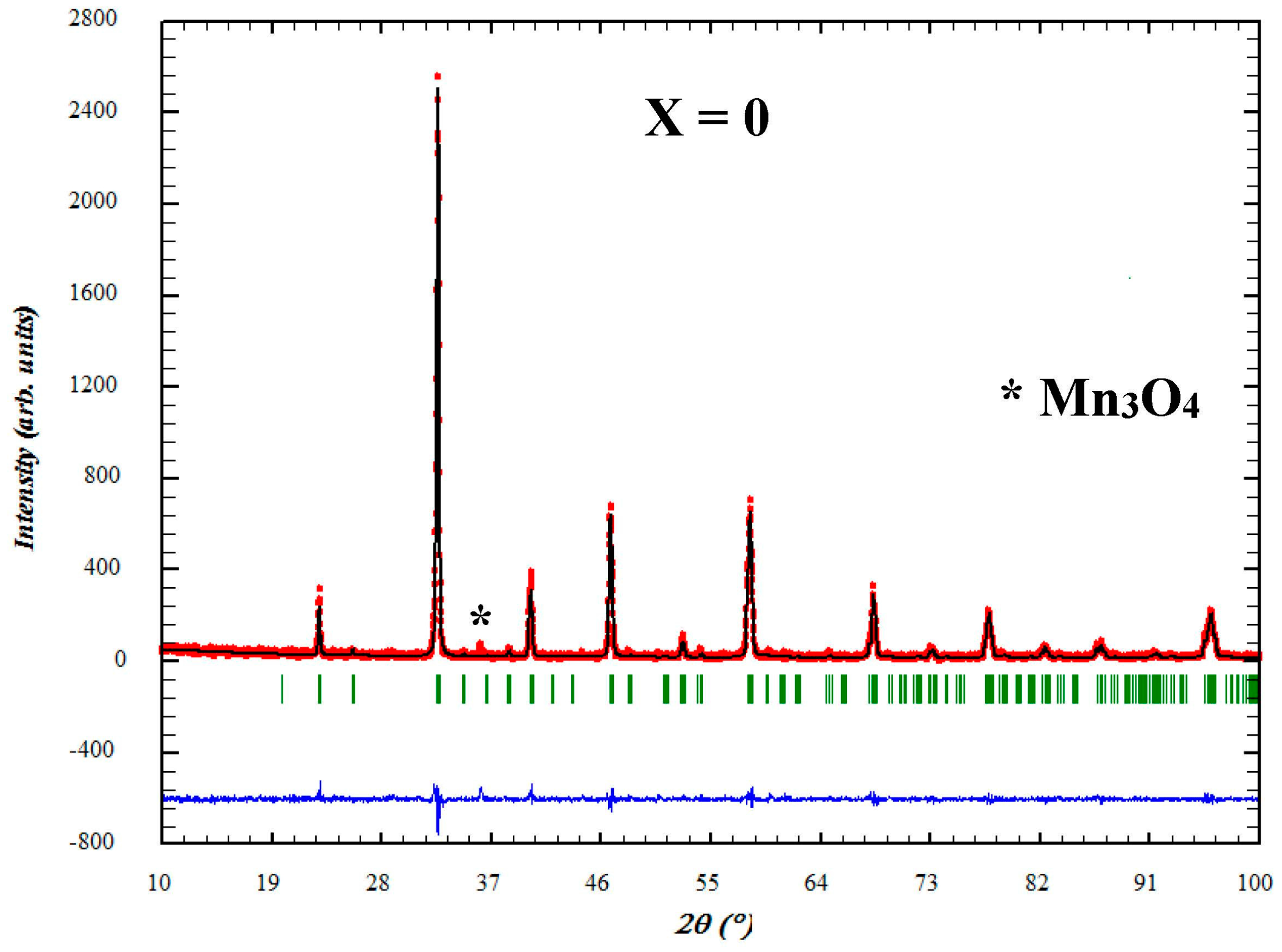
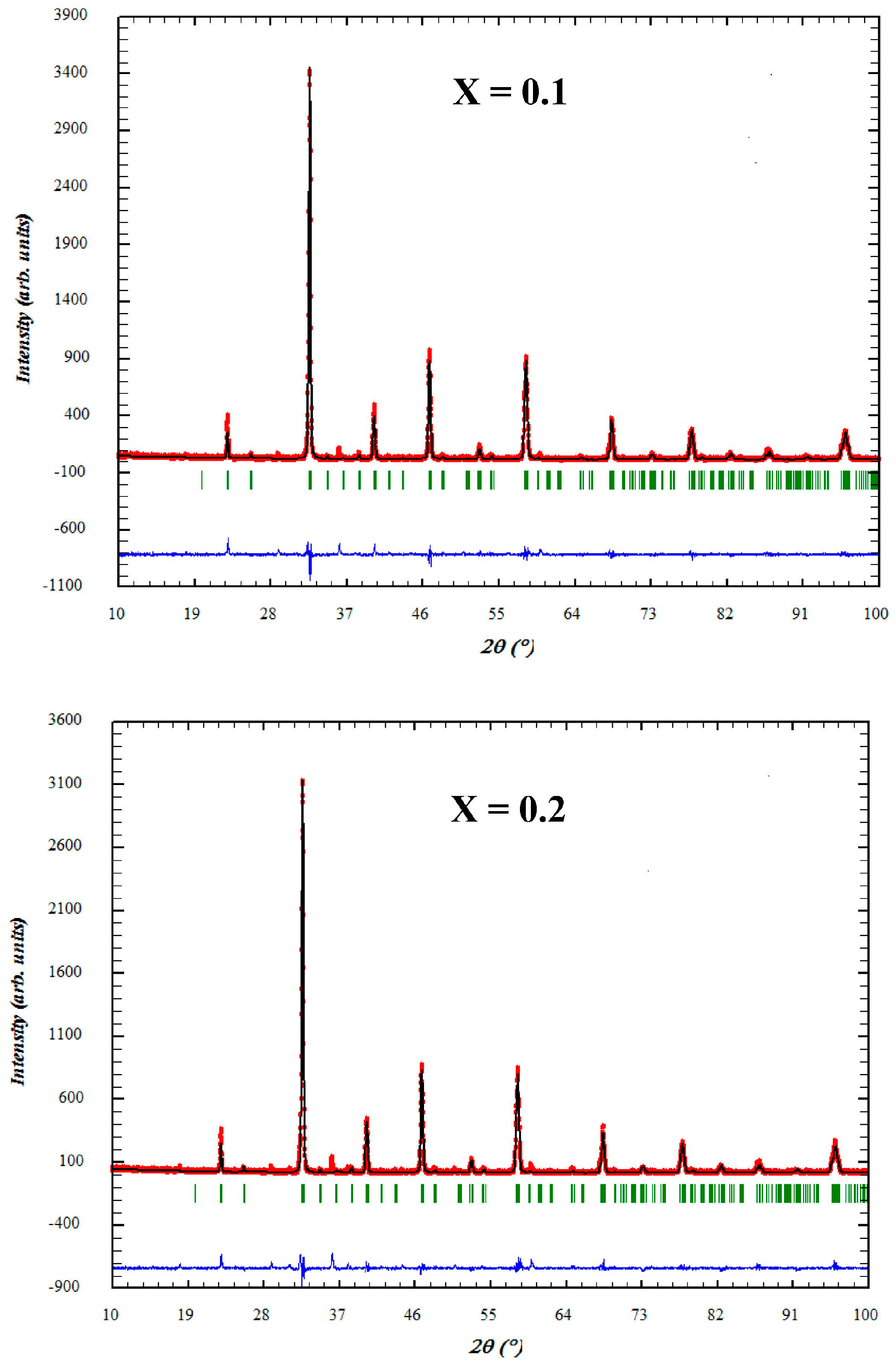
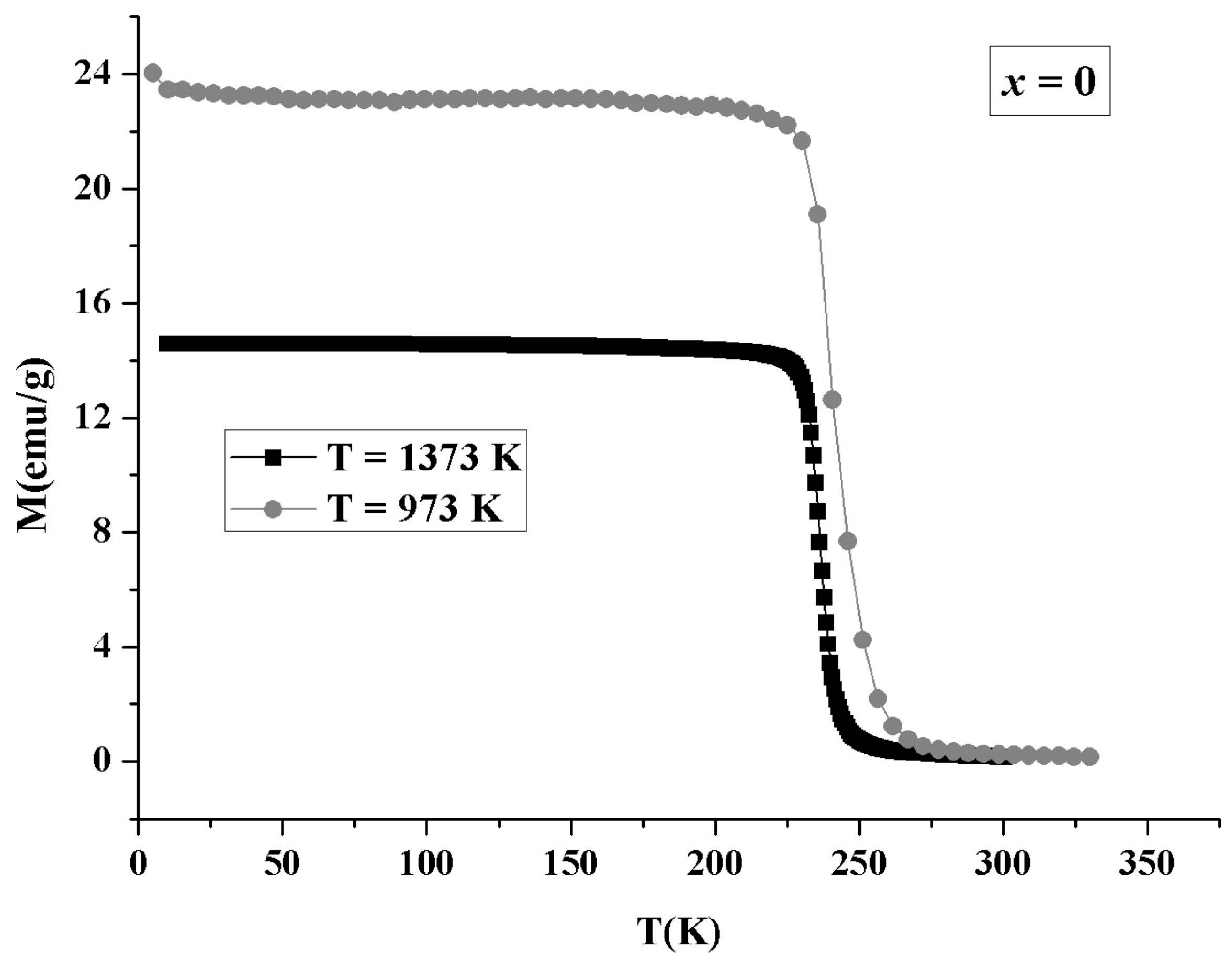
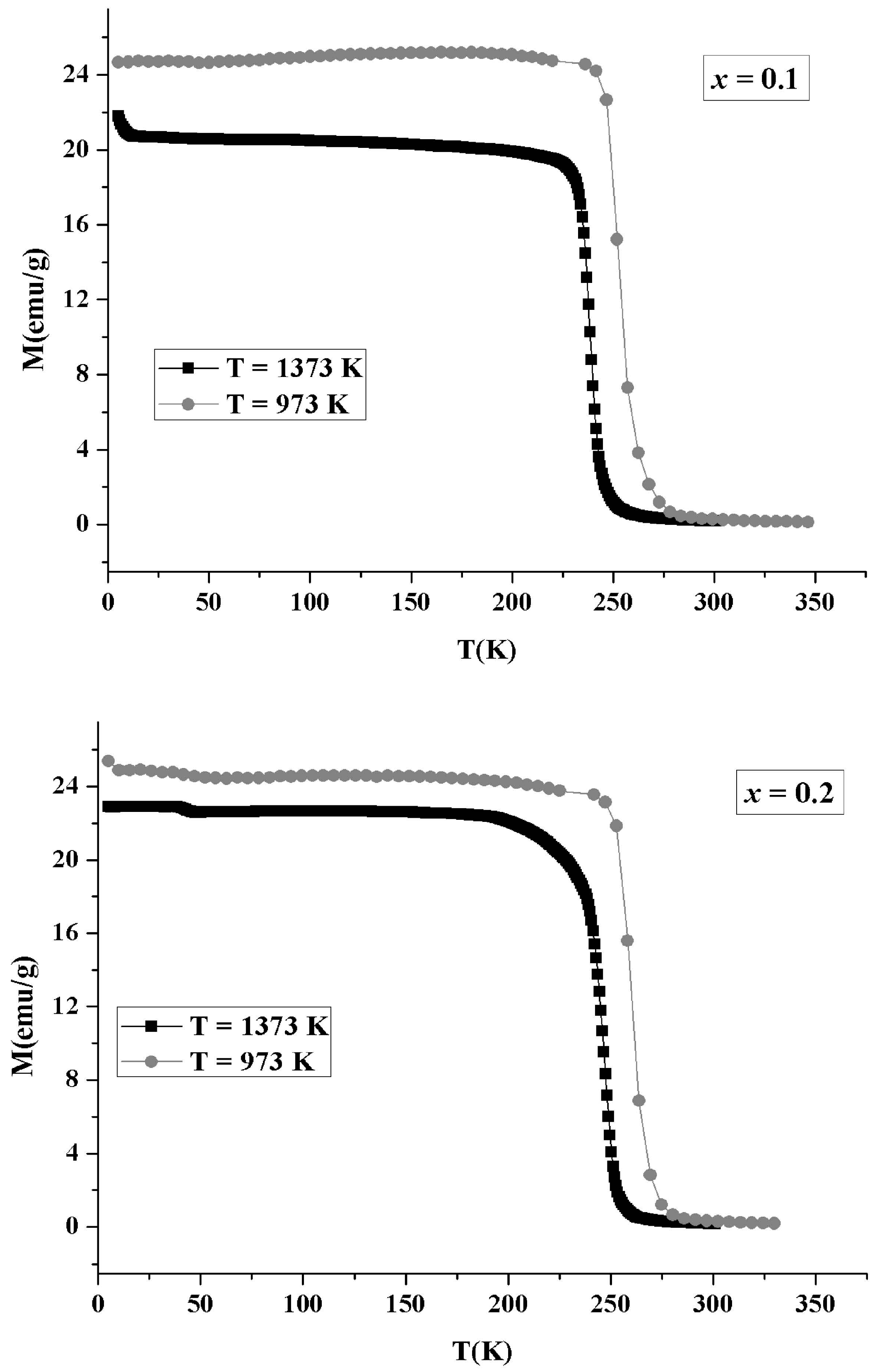
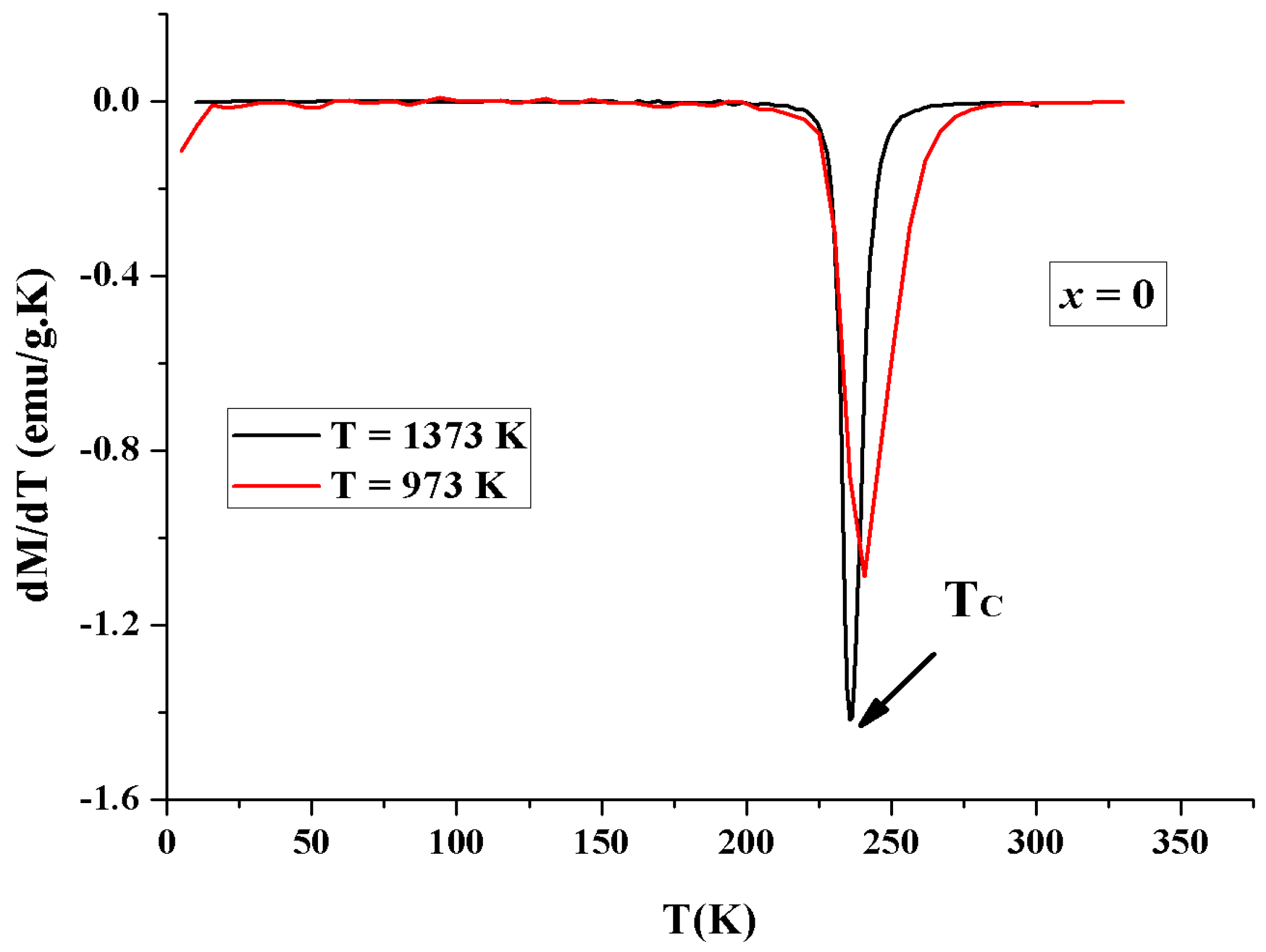
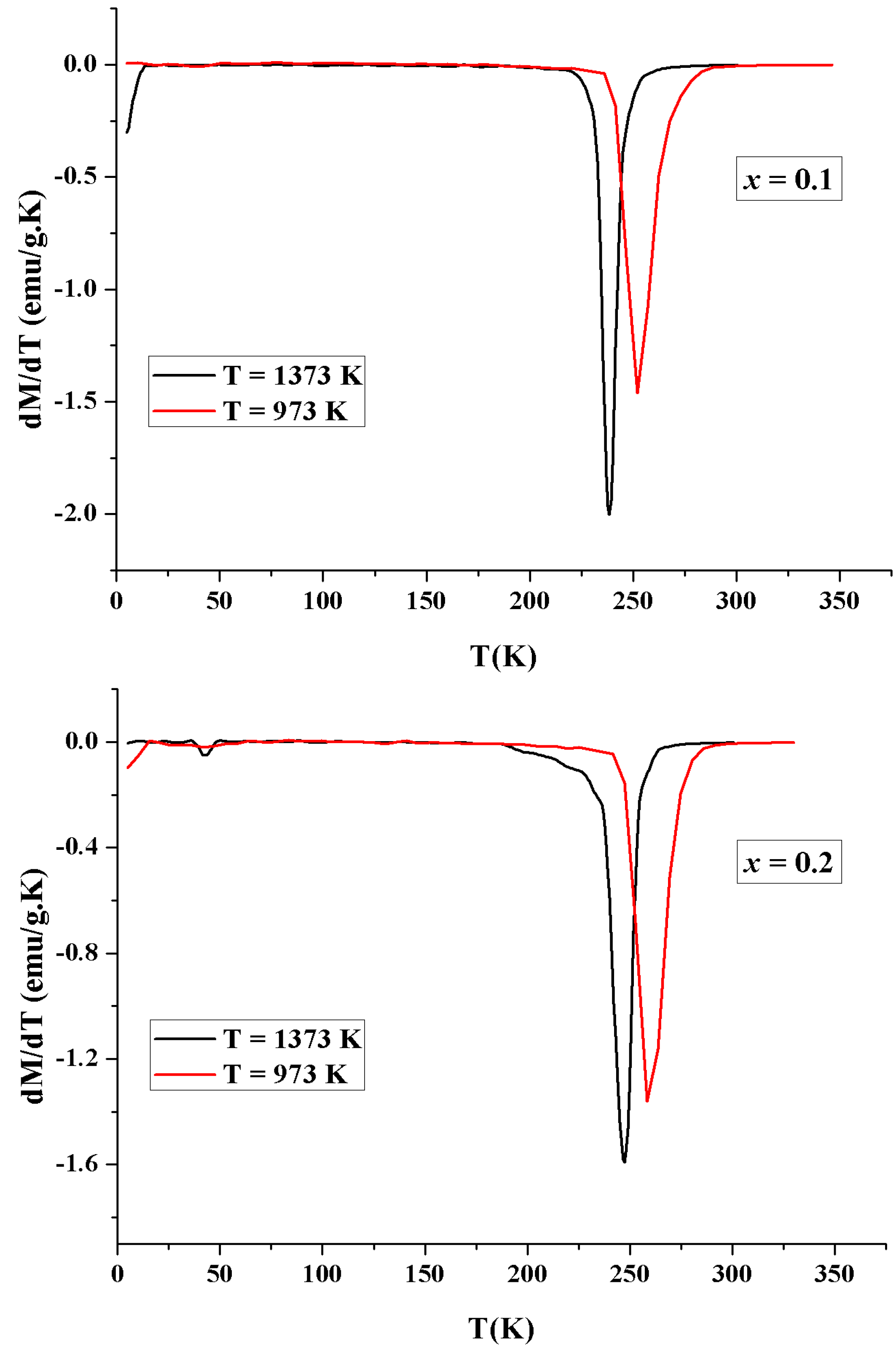
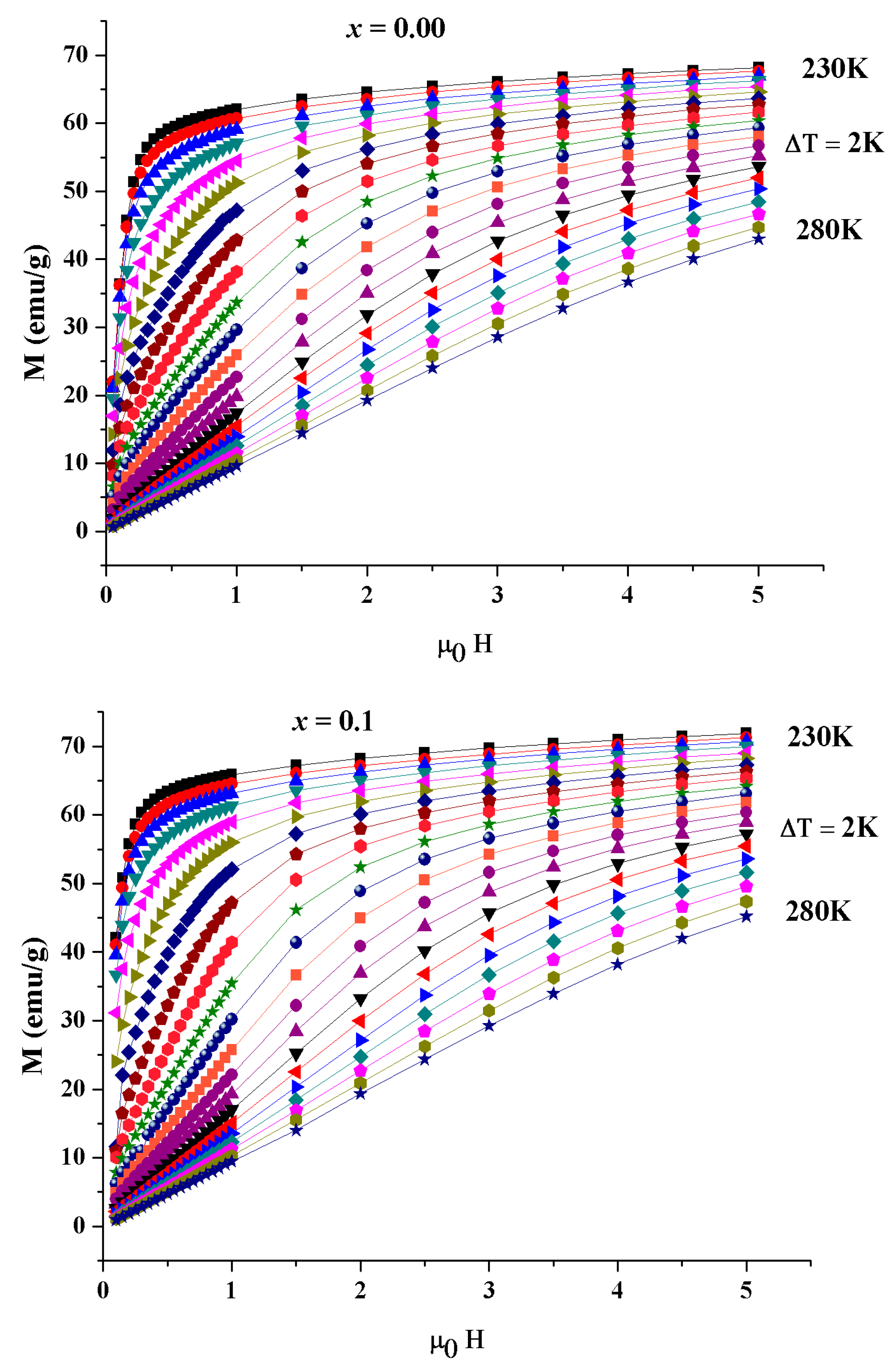



| x | 0 | 0.1 | 0.2 |
|---|---|---|---|
| Space group | Pnma | Pnma | Pnma |
| Lattice parameter | |||
| a (Å) | 5.4503 | 5.448 | 5.446 |
| b (Å) | 7.712 | 7.709 | 7.707 |
| c (Å) | 5.474 | 5.468 | 5.463 |
| Unit cell volume (Å3) | 57.522 | 57.437 | 57.412 |
| dMn–O (Å) | 1.967 | 1.958 | 1.952 |
| θMn–O–Mn (°) | 161.234 | 161.012 | 160.453 |
| χ2 (%) | 1.27 | 1.51 | 1.51 |
| Tannealing = 1373 K | Tannealing = 973 K | |||||
|---|---|---|---|---|---|---|
| x = 0 | x = 0.1 | x = 0.2 | x = 0 | x = 0.1 | x = 0.2 | |
| TC (K) | 236 | 241 | 247 | 240 | 252 | 258 |
| W /W0 (10−2 eV) | 9.05 | 9.14 | 9.28 | 9.361 | 9.498 | 9.544 |
| Materials | TC (K) | μ0H (T) | −ΔSM max (J/K kg) | RCP (J/kg) | References |
|---|---|---|---|---|---|
| Gd | 299 | 2 | 5 | 196 | [29] |
| 335 | 2 | 2.83 | 76.91 | [23] | |
| 320 | 2 | 2.97 | 96.06 | [23] | |
| 295 | 2 | 2.97 | 96.06 | [23] | |
| 240 | 2 | 3.84 | 95.15 | This work | |
| 252 | 2 | 2.98 | 96.17 | This work | |
| 258 | 2 | 4.56 | 83.97 | This work |
© 2017 by the authors. Licensee MDPI, Basel, Switzerland. This article is an open access article distributed under the terms and conditions of the Creative Commons Attribution (CC BY) license (http://creativecommons.org/licenses/by/4.0/).
Share and Cite
Ridha, S.; Essebti, D.; Hlil, E.K. Impact of Annealing Temperature on the Physical Properties of the Lanthanum Deficiency Manganites. Crystals 2017, 7, 301. https://doi.org/10.3390/cryst7100301
Ridha S, Essebti D, Hlil EK. Impact of Annealing Temperature on the Physical Properties of the Lanthanum Deficiency Manganites. Crystals. 2017; 7(10):301. https://doi.org/10.3390/cryst7100301
Chicago/Turabian StyleRidha, Skini, Dhahri Essebti, and El Kebir Hlil. 2017. "Impact of Annealing Temperature on the Physical Properties of the Lanthanum Deficiency Manganites" Crystals 7, no. 10: 301. https://doi.org/10.3390/cryst7100301




